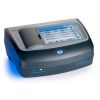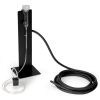Hach DR1900 Portable Spectrophotometer
The Hach DR1900 portable spectrophotometer is perfect for use in the field because of the lightweight and compact design.
Features
- Carry anywhere due to a thoughtful, compact design
- Ensure accuracy in the field
- Clear, easy-to-use interface
- Free ground shipping
- Expedited repair and warranty service
- Lifetime technical support
- More
Overview
The Hach DR1900 portable spectrophotometer excels in the field because of the lightweight and compact design. The DR1900 is built for rugged conditions, and it’s flexible, --accepting the widest range of vial sizes.
Built with field use in mind, the DR1900 has a large, clear screen and a simple user interface that makes testing easier than ever in even the most demanding conditions.
Advanced Testing
Easy to hold, and operate, the compact DR1900 is a valuable tool for your field technicians. Underneath the rugged exterior, the DR1900 has the largest number,-- over 220-- of the most commonly tested preprogrammed methods already built in. You can also use the easy-to-use interface to create your own methods.
Tests are performed with a wavelength range of 340 to 800 nm which make this a field instrument you can use to find results typically only seen in laboratory instruments.
Notes
Reagents listed below are EPA approved. For the full list of reagents and methods that can be used with the DR1900, refer to the Hach Methods Quick Reference Guide
TNTplus vial test evaluation possible, but without barcode identification & 10 fold measurement and outlier elimination.
- Battery Life: 15 days (typical) @ 5 readings a day / 5 day week without backlight*
- Battery Requirements: 4, AA size alkali cells
- Cuvette Compatibility 2: 10 mm square / 1 inch square and 13 mm / 16 mm / 1 inch round
- Data Logger: 500 measured values (Result, Date, Time, Sample ID, User ID acc. to GLP)
- Detector: Silicon photodiode
- Dimensions (H x W x D): 98 mm x 178 mm x 267 mm
- Display: Graphical display 240 x 160 pixel (LCD, b/w, backlit)
- Enclosure Rating: IP67
- Interface: USB type Mini IP67 (with USB + Power Module)
- Mains Connection 2: 110 - 240 V / 50/60 Hz (* optional Module required. May not be available in all regions)
- Mains Connection 3: 4x NiMH rechargeable Battery (* optional Module required. May not be avaliable in all region)
- Operating Conditions: 10 - 40 °C (50 - 104 °F), max. 80 % relative humidity (non-condensing)
- Operating Humidity: Max. 80 % relative humidity (non-condensing)
- Operating Mode: Transmittance (%), Absorbance and Concentration
- Operating Temperature: 10 - 40 °C
- Optical System: Reference beam, spectral
- Photometric Accuracy: ± 0.003 Abs @ 0.0 - 0.5 Abs
- Photometric Linearity: < 0.5 % (0.5 - 2.0 Abs)
- Photometric Measuring Range: 0 - 3 Abs (wavelength range 340 - 800 nm)
- Power Module?: Yes
- Power Supply: 4 x AA size Alkaline
4x NiMH rechargeable Battery
Power supply: 110 - 240 V; 50/60 Hz - Region: US
- Reproducibility: ± 0.005 Abs (0 - 1 A)
- Sample Cell Compatibility: 13 / 16 mm and 1 inch round 10 x 10 mm 1 inch square adapter for round vials and 10x10mm
- Source Lamp: Xenon Flash
- Storage Conditions: -30 - 60 °C (-30 - 140 °F), max. 80 % relative humidity (non-condensing)
- Stray Light: < 0.5 %T at 340 nm with NaNO2
- Temperature Range: 0 - 50 °C (32 - 122 °F)
- User Interface Languages: English, French, German, Italian, Spanish, Portuguese, Bulgarian, Chinese, Czech, Danish, Dutch, Finnish, Greek, Hungarian, Japanese, Korean, Polish, Romanian, Russian, Slovenian, Swedish, Turkish
- User Programs: 50
- Warranty: 12 months
- Wavelength Accuracy: ± 2 nm (range 340 - 800nm)
- Wavelength Calibration: Automatic
- Wavelength Range: 340 - 800 nm
- Wavelength Selection: Automatic
- Weight: 1.5 kg
- What's included?: portable spectrometer, printed basic instrument manual, dust cover, 1-in. square matched glass sample cells, AA alkaline batteries 4/pk, a four-type vial adapter set, and a USB + Power module (LZV813).
* Backlight usage will decrease battery life.
- Portable spectrometer
- Printed basic instrument manual
- Dust cover
- 1-in. square matched glass sample cells
- AA alkaline batteries 4/pk
- Four-type vial adapter set
- USB + Power module (LZV813.99.00002)
In The News
Monitoring Meadowbrook Creek: Real-Time Data Collection in an Urban Creek
Meadowbrook Creek in Syracuse, New York, has been monitored by Syracuse University (SU) faculty and students for over a decade. Originally established by Dr. Laura Lautz in 2012, the early years of the program focused on collecting grab water samples for laboratory analysis and evaluating the impact of urban land use, human activities, and natural processes on water resources. Tao Wen , an Assistant Professor in SU’s Department of Earth and Environmental Sciences, took over the program in 2020 and upgraded the existing systems to include 4G modems that allowed for real-time data viewing. [caption id="attachment_39339" align="alignnone" width="940"] An overview of the Fellows Ave monitoring station along Meadowbrook Creek.
Read MoreLancaster County Makes the Switch to Real-Time Water Quality Monitoring Systems
Continuous data collection in Lancaster County, Pennsylvania, started about 5 years ago, and the county will be making a major upgrade over the next year—switching from relying solely on the internal storage of water quality sondes to telemetry units that enable real-time data viewing. [caption id="attachment_39295" align="alignnone" width="940"] The first telemetry unit was installed at LCCD along Little Conestoga Creek. (Credit: Tyler Keefer / LCCD) [/caption] Telling Lancaster County's Story Through Data Since the Lancaster County Conservation District started monitoring county waterways, the goal has remained the same, according to Amanda Goldsmith, Watershed Specialist for the Watershed Department.
Read MoreFrom Florida to the World: How a Smithsonian Research Station is Bridging Gaps in Marine Biology
In the early 2000s, along the coast of northern California, where the redwoods dominate the forests, and the Pacific Ocean shapes shorelines, a Humboldt University undergraduate student took the first steps into a lifelong love of marine biology. Dean Janiak accepted an invitation to help a graduate student with fieldwork in rocky coastal tide pools, and so began a journey that led him from California to Connecticut to Florida and eventually to the world, where he has facilitated research in communities across the globe. While finishing up his masters of Oceanography from the University of Connecticut, Janiak continued researching fouling communities–marine life that live on hard, often artificial surfaces such as docks–at the Smithsonian Environmental Research Center.
Read More




























































